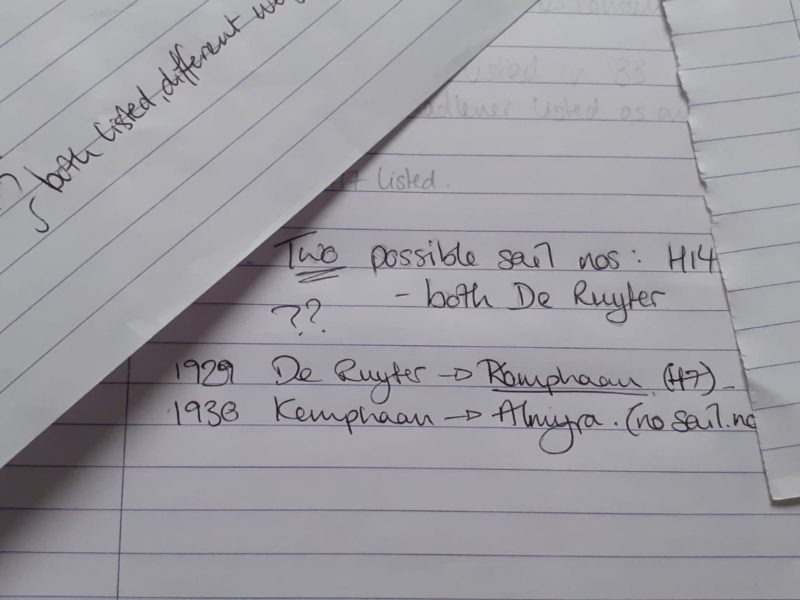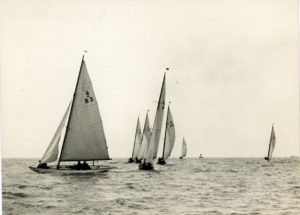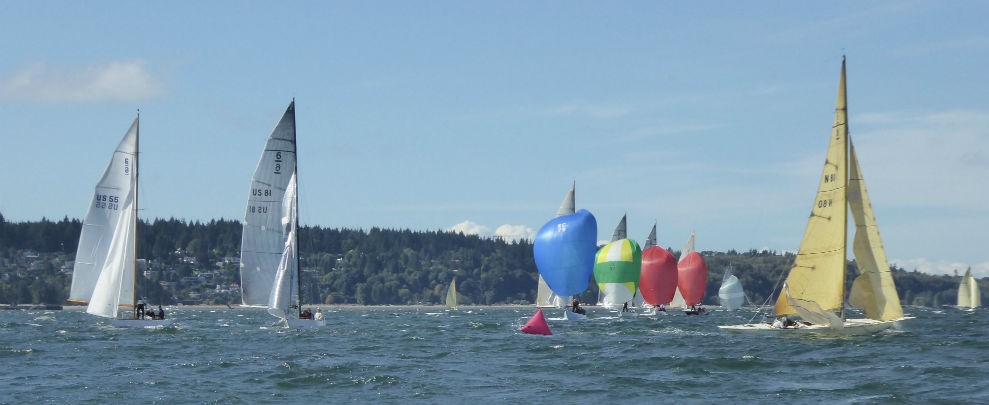Following the threads – a research puzzle
November 10th, 2021

Sometimes research questions pop up unexpectedly, often prompted by new additions to the collection. Our archivist tells us about a recent research puzzle that left her head in a spin!

The sail number “H2” in this image confused our archivist. With no record of an H2 listed in our records, she had to work out which boat it was. It was eventually discovered to be Kemphaan, built in 1927.
“We were recently sent some photographs taken in the late 1920s of Six Metres racing in the Netherlands and Belgium. During the process of cataloguing the
images, it became clear that there were some anomalies in our records that didn’t quite tie up. Why did we not have two of the sail numbers listed in our records? And were we sure the boats we had listed were the ones in the photo? I decided to try and unpick what was going on, not realising at the time that I would end up dealing with a tangled mess of boats to carefully pull apart.
A prolific designer
“Many of the Dutch boats from the 1920s were designed and built by the de Vries Lentsch family who operated out of the Amsterdamsche Scheepswerf.

Four of the boats in this photograph were designed and built by G de Vries Lentsch. From archive record BSCM.1.76.
Between 1909 and 1930 the yard designed or built more than 20 Six Metres. Among them were a number of boats with shared names: they built five boats named Neerlandia in just four years, and, according to our database, four named De Ruyter (after the celebrated Dutch admiral) and two with the name Kemphaan.
“Of course, we know that owners like to change the name of boats, and each of these boats had been called either De Ruyter or Kemphaan (or both) at various points in their lives. Add into the mix an Almira, Almyra and Almeri, and you might start to grasp the complexity of the muddle. Fast forward to the 21st century, and this now created a lot of confusion for those of us trying to work out which boat is which. It certainly doesn’t help that in 1937 the records show that there were three De Ruyters, all registered in Amsterdam and all with the same designer. One thing that was really bothering me was that one boat built in 1930 was named Kemphaan IV, but we only had two listed. What on earth had happened to the other two?
Detective work
“Something in our records wasn’t adding up, and I needed to do something about it. This isn’t just for my own satisfaction (although that does come into it!), but to help with keeping our records as accurate as we can. Those of you who use the site regularly will be aware that our boat profiles and archive records are linked together – so how can we link them correctly if we know our records are wrong?

There were three Six Metres named De Ruyter registered in Amsterdam in 1937.
“After many hours of head scratching and scribbling more than a dozen pages of notes, the truth (as least I think I’m there now!) finally emerged, the fog lifted and the full picture became clear. Where we had had six boats recorded, there were actually nine – and so three newly recorded Six Metres have been added to the list. Two of them were also named Kemphaan, completing the part of the puzzle that had been bothering me most.
“It is interesting to see that even the historic records from the 1920s don’t seem to tie up either; it appears that this particular group of boats has been causing confusion for a century. I did my best with the resources available, but I am always aware that our records cannot be seen as definitive; they are more a work in progress, and the best information we have to date.
“There are all sorts of anomalies in the records, but, with time – and building on the incredible work that has been done in the past – a fuller and more accurate picture of the class will emerge. Almost every time we upload a new archive to the site, we find something new, something that can add not only to our understanding of the class, but to the knowledge and resource that we make available to our site’s visitors and researchers, like fitting together the pieces of Six Metre jigsaw puzzle.
“And a final plea to current Six Metre owners – please consider the poor historians of the future when renaming your boats!”
Posted in Behind the scenes, Collections by Jenny Wittamore on November 10th, 2021.
Subscribe to comments | Both comments and pings are currently closed.
We need your support
Support our project and submit your records or make a donation to the International Six Metre Archive.
